The Journals of Ayn Rand Read online
Page 24
She is now leaving to go to the trial. (She can’t do that! he objects. He can‘t, she answers, but she can. She is not the Wynand papers.) And before leaving she tells him that there is not much that he can do now, anyway, about their marriage: she hands him a copy of his own paper, where, on the front page, is a statement signed “Gail Wynand,” denouncing Dominique, insulting her, putting all blame on her, announcing to the world that he is going to divorce her. Wynand is unable to speak. Dominique can now feel pity for him. “Don’t, Gail. I understand. I know who wrote it. Don’t blame him too much. He had to. You had to.” She leaves for the trial.
The trial. Roark enters, his head bandaged, his left arm in a sling. He is greeted by cheers, applause and hisses. The public sentiment is now divided about him. The judge threatens to clear the court, “if they don’t remember that it is a courtroom, not a news-reel theater.” The photographers have a swell time photographing Dominique as she enters. She pays no attention. She sees no one but Roark.
The progress of the trial. The prosecution has an army of witnesses. (Perhaps even Dominique—to supply the motive as Roark’s hatred for Peter.) The defense tactics—“no questions.” No cross-examination whatever, not even of Peter, who has some terrible moments on the stand and behaves like a piece of pulp. Peter, however, does not confess the truth and is not asked to.
Wynand does appear in the courtroom—once. Thereafter, the editor prevents it. When the defense’s turn comes, the old lawyer has but one witness to call—Howard Roark. After the first formalities of name, profession, etc., the lawyer asks: “Mr. Roark, what connection did you have with the project known as [Cortlandt Homes]?” Roark answers, very quietly: “I designed it.” [Then comes] the whole story of the contract with Peter. The contract is introduced in evidence. Before Peter can be warned by the prosecution or collect his wits, he has admitted his signature and the truth of the story. The defense rests.
The old lawyer’s closing speech—summation of what Roark is, of his standards, of his value to mankind. No plea for pity. No apology. A quiet defiance. A “This-is-what-he-is-now-dare-to-convict-him,-if you-can” feeling. The jury retires to deliberate.
Jury out all evening and night. Possible scene of Roark, Dominique, old lawyer, some others waiting together for verdict. Roark talks—of everything but the jury and trial. The only time he can be poetic, almost tender(?).
Next morning. The verdict: “Not guilty. ” The judge furious. It comes out that the first ballot was eleven ... guilty to one ... not guilty. The one swung the eleven. (Plant this one man earlier, his reasons, his psychology.) Dominique leaves courtroom as soon as verdict is rendered. She does not approach Roark. “Home and to bed!” the old lawyer orders him. “To the Ford building!” orders Roark.
Ovation of workers at the Ford building. (They have been listening on the radio to the verdict.) Then at Roark’s office: The one “capitalist” on the housing project has announced that he is buying it from the state and will have Roark do it as it was intended. Other commissions—from sensation seekers....
Then Roark comes home. Dominique is waiting for him there. Their one real, complete love scene. She will go away, not to disturb him now when his work needs him; also to “find herself”—adjust herself to her new life. Then she will come back. They will be together forever.
The Wynand papers have been doing beautifully during the trial. Circulation is boosted by a “succes de scandale.” Everyone reads the Wynand papers to see how they “take it.” The editor takes advantage of it. He prints hints, double-meanings, “between-the-lines” allusions, things that will be quoted and discussed and gloated over; he builds up Wynand as a moral, outraged man. He is delighted with and boasts to Wynand (without noticing Wynand’s horror) about the tons of fan mail arriving for Wynand, letters of sympathy and advice from good housewives, proposals of marriage from spinsters who promise not to “treat him that way” and to “make him forget.” And Dominique, whom Wynand had tried so desperately to keep from the mob, whose pictures were never allowed in the press, is now splashed across every front page in the country, including the Wynand papers. (Incident with paper in the gutter.) When a political event occurs that is in line with the Wynand papers’ policy and throws a great deal of sympathy to them, when a noted gossip columnist decides to join the Wynand papers, the editor’s victory is complete. The Wynand papers are back. The editor even goes so far as to say before Wynand that the whole affair was a swell stunt for them, after all.
Wynand takes it all as in a daze, with the greatest indifference possible. He lets it be done. He does not even wince often. Dominique leaves for Europe. Wynand divorces her—in a short, horrible scene in which he repudiates her publicly. It is Wynand’s greatest agony. He goes through it like an automaton. He is led by the editor completely. He has not gathered the pieces of his spirit enough to act for himself.
Peter’s complete downfall. Short scene of his accepting an inferior commission, a home in the “Greek” style (“like his library”).
Toohey’s defeat and new plans, grander than ever.
Very shortly after the divorce, the question of the Wynand Building comes up. The time is considered “just right” in view of “the triumph.” The board of directors is in session to decide on the architectural competition for “the greatest building in the world.” This is Wynand’s last gesture. All that he has gathered of his spirit now goes into this—as a challenge to that new triumph which he hates. He rises. “Gentlemen, there will be no contest. I have chosen the architect who will do the Wynand Building. His name is Howard Roark.” Dead silence. The sole reaction is one choked hiccough from some unimportant little guy. Wynand looks at the stunned faces, pouncing on them ferociously: “Well? Has no one here anything to say? I take it that you approve of my choice, gentlemen?” In the silence, the editor gasps: “You’re mad, Gail!” Wynand whirls on him: “Why? Because he’s sleeping with my wife? Because I hate him more than any man living? And because he alone can give us the greatest building in the world? ... The matter is settled, gentlemen. I wish you a good day.” He leaves the conference room.
Nothing can sway Wynand in this, his last, his only real decision. To the frantic pleas of the editor, he answers only that he does not give a damn any more about “his public” and “his papers.” He has enough to live on. He doesn’t care whether the papers go on or fail. He has no heirs to leave them to. The public will accept it—he doesn’t care; the public won’t accept it—he cares less. But he will have this one thing out of his life, when he has lost all the rest; one thing that he wants.
Roark is informed. He is called to Wynand’s office. He comes. Wynand meets him alone in his office, coldly, formally. There is no allusion to anything but the building. Wynand informs him briefly, generally of the requirements, the kind of building he wants from the angle of utility, its purpose. The rest is up to Roark. He will have an unlimited budget. There will be no orders given by anyone but him. He is to design and build it as he pleases. It is to be the greatest building in the world. He does not even have to submit his design for approval; it is approved in advance. If Roark accepts the job, he will find the contracts ready in the outer office; Wynand has signed them; all Roark has to do is to sign. Roark accepts. He is as calm, as cold, as unsur prised as is Wynand.
Then Wynand says, with a little different note in his voice: “I do not wish ever to see you again. I do not wish to speak to you. You will find my manager ready at any time for any orders you may want to give. I do not have to see you.” His hatred, almost his insult, is apparent. Roark agrees calmly. Then, without looking at him, Wynand says softly what that building had been intended to be and mean, how he had planned for it through the years, the crowning glory, the symbol of his life. He looks at Roark suddenly. He adds: “I have nothing to crown now, nothing to celebrate. I have nothing to go into that building—except what you’ll put into it.” He rises. His greatest moment. The sum and the summit of his life. Everything he has is in the words: “Build it as a monument to that spirit which is yours ... and ... could have been mine.”
About eight months later (less, if possible). Dominique returns from Europe. She has not written to Roark of her return. She goes to his office-he is at the Wynand Building. She goes to building. The steel skeleton is up. She stands looking at it. Then she notices a thing which makes her tremble suddenly and lean against a wall. She looks at the street, at the people around her. She feels suddenly the greatest of all events, the greatest of all triumphs, the victory of all the “great unsung” over all the filth of the pavements and those upon them; she sees all of society in a flash—and what it means; she sees all those whom it has crushed and passed by—and their vindication. She has seen a small, dirty tin plate nailed to the scaffolding of the Wynand Building:“Howard Roark, Architect”
She goes into the building. She is told that Roark is above, on top of the building. She takes an open freight elevator to go up. As it begins to rise slowly, we rise with her above the pavements, above the shops, the theaters, the houses, the church spires, above all that men do and are. (The writing accelerates here with the growing speed of the elevator as it rises.) She is above everything, with nothing but the sky and the distant ocean rising on the horizon. Then she sees, alone, tall, erect against the sky, Howard Roark on the top of the building, his red hair flying in the wind.
April 25, 1938
I. 1922-1928: Peter Keating (6 years)
From graduation to Roark’s failure. The competition which Peter wins and his definite establishment. This is Peter’s story. II. 1928-1931: Ellsworth M. Toohey (3 years)
From quarry to start of summer resort project. The affair of Roark-Dominique. Dominique marries Peter. Roark-Toohey. This is Toohey’s story. III. 1931
-1935: Gail Wynand (4 years)
No relations between Roark-Dominique. Roark’s slow rise. The summer resort project’s “J‘accuse” [in reference to the discovery of the fraudulent investment scheme]. Dominique marries Wynand. Peter’s problems and beginning of downfall (the Exposition). Wynand’s story. IV. 1935-1938: Howard Roark (3 years)
Roark’s commission for the Wynand Country House. Dominique’s regeneration. The housing project. The Ford Building. The trial. The Wynand Building. Roark’s story.
May 15, 1938
Roark and Toohey as the two poles of good and evil.
Everything that happens to the others in the book is according to the principles either of Roark or of Toohey. These principles are illustrated by the actions of the two men. In their relations to these two, and in the influence of these two, the [other] characters play out the drama which illustrates the two life-principles.
The others are: Dominique, Peter, Wynand.
Dominique: The Toohey principles have forced her into a bitter cynicism about all life. She is born above these principles, and not ready as yet for those of Roark, because nothing in life has ever taught her the Roark philosophy. Her story is the struggle against the Toohey principle to win through to Roark.
Wynand: He has lived according to Toohey all his life and has never believed in it. He is only too ready for Roark and knows it the moment he meets him. His story is the conscious struggle against the Roark principle, only to surrender to it in the end.
Peter: Unfit for any principle. The clay with which Toohey builds. He could have, perhaps, achieved a shadow of self-vindication with Roark. He reaches the bottom of waste and tragedy with Toohey.
Roark: integrity, loyalty to yourself.
Toohey: exist for, by and through others.
Roark brings out and encourages every form of truth to self. Toohey destroys every vestige of it, leaving about him a sterile desert.
June 15, 1938
First Draft of Chapter Plan Part I: Peter Keating
I
Spring, 1922. Howard Roark alone in the mountains. His return to the city. The interview with the principal about his being expelled.
II
Same day. Peter Keating at the commencement celebration.
III
Same evening. Peter comes home. Vesta Dunning. Roark’s plan for their life together in New York.
IV
In New York: the new household. Peter’s introduction into Francon’s office. Roark-old master [Henry Cameron]: first meeting, hired.
V
One week later. Roark’s first work for old master. Scene where Roark is fired—and their first real understanding. At home: Vesta-Roark. Peter.
VI
Fall, 1922. Peter’s first accomplishments in the Francon office—professional and personal. The affair: Roark-Vesta.
VII
Winter, 1922-23. Roark’s struggle with old master. Peter’s loves. The beginning of Vesta’s conflict with Roark.
VIII
Winter, 1923-24. Peter has moved out. Peter’s rise with Francon. Old master gives up.
IX
Peter brings Roark to Francon’s office. The clashes. Mike.
X
Winter, 1925. Roark fired. Break with Vesta.
XI
Beaux Arts bribe. Roark in new job.
XII
Peter sees Dominique in Francon’s office.
XIII
Spring, 1926. Roark gets his first commission from the critic [Austen Heller, whom she refers to as “Mencken ” in one cryptic note from this period]. Peters meets Dominique.
XIV
Summer, 1926. Peter’s attempts at romance with Dominique. Critic’s home finished. Public reaction—or lack of it.
XV
Winter, 1926-27. Other commissions for Roark. His struggle. His second mistress [Heddy Adler, who was later cut from the novel]. The competition for the library.
XVI
Summer, 1927. Roark’s struggle.
XVII
Winter, 1928. Roark’s downfall. Staking all on one commission. He refuses his mistress’ proposal. Peter-Dominique, their kiss, her indifference. Peter beginning to dislike her definitely.
XVIII
Spring, 1928. Peter wins the competition. Roark refuses to take commission he was counting on. Roark leaves for Connecticut. The party celebrating Peter’s partnership in Francon’s firm.
[AR made similar outlines for the rest of the book. I have included here only those descriptions in which AR makes a comment of special interest or mentions an event that did not occur in the novel.]
[Part II: Ellsworth Toohey]
V
Toohey—past, present, future. Toohey and the Wynand paper. Dominique-Toohey, Peter-Toohey. [Note added later:] Incident about Roark’s building—“Independent as an insult, isn’t it?” [...]
IX
Summer, 1929. Escape of contractor for Unfinished Symphony. Toohey-Dominique. She prints the libel.
X
Lawsuit and love affair. Roark-Dominique.
XI
Fall, 1929. Roark wins the suit. That night. Next day—Symphony stopped. A few days later—Dominique marries Peter. Her wedding night with Roark. Next morning—she tells him. Their break. [...]
XVI
Fall, 1930. Roark loses [the Stoddard Temple] lawsuit and everything. Sculptor’s [Steven Mallory‘s] suicide—“for Roark’s sake.” Roark goes to live in Unfinished Symphony. Toohey and the Wynand Settlement project. Plans for Peter, and for Dominique to meet Wynand. Temple altered by Peter. Scene of Roark on steps of Temple, at night, in the snow, his hat off, his hands patting the steps. Scene: Roark-Toohey.
Part III: Gail Wynand
III
Roark’s [commission for] the nightclub. Roark living in Symphony. Meeting with young writer. [...]
VIII
Spring, 1931. Young writer’s death. Roark leaves for summer [resort] project. Peter and the Wynand Settlement. Peter-Toohey. [...]
XII
Dominique’s reactions to Roark’s mistresses. Dominique-Wynand.
XIII
Spring, 1933. Opening of summer resort. Great success. Panic of promoters. Roark and mistress at opening. Dominique there alone.
XIV
The flood. Night. Next morning. [AR’s original idea was that Monadnock Valley was subject to periodic flooding, and the promoters had counted on the summer resort being destroyed by a flood. Their plan fails because Roark designs the resort such that it can withstand the floods.] [...]
Part IV: Howard Roark
VI
Peter marries blonde. Scene: Toohey-niece.

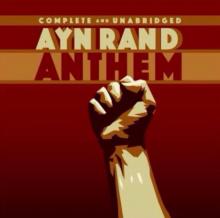 Anthem
Anthem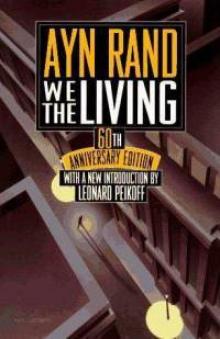 We the Living
We the Living Atlas Shrugged
Atlas Shrugged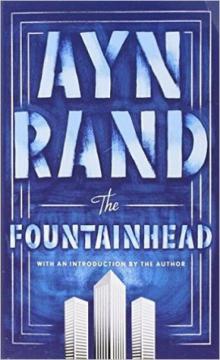 The Fountainhead
The Fountainhead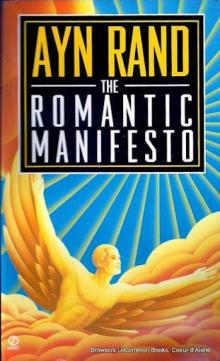 The Romantic Manifesto: A Philosophy of Literature
The Romantic Manifesto: A Philosophy of Literature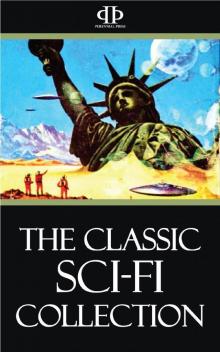 The Classic Sci-Fi Collection
The Classic Sci-Fi Collection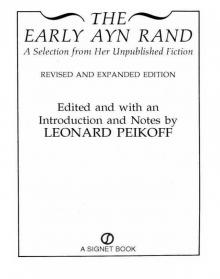 The Early Ayn Rand
The Early Ayn Rand